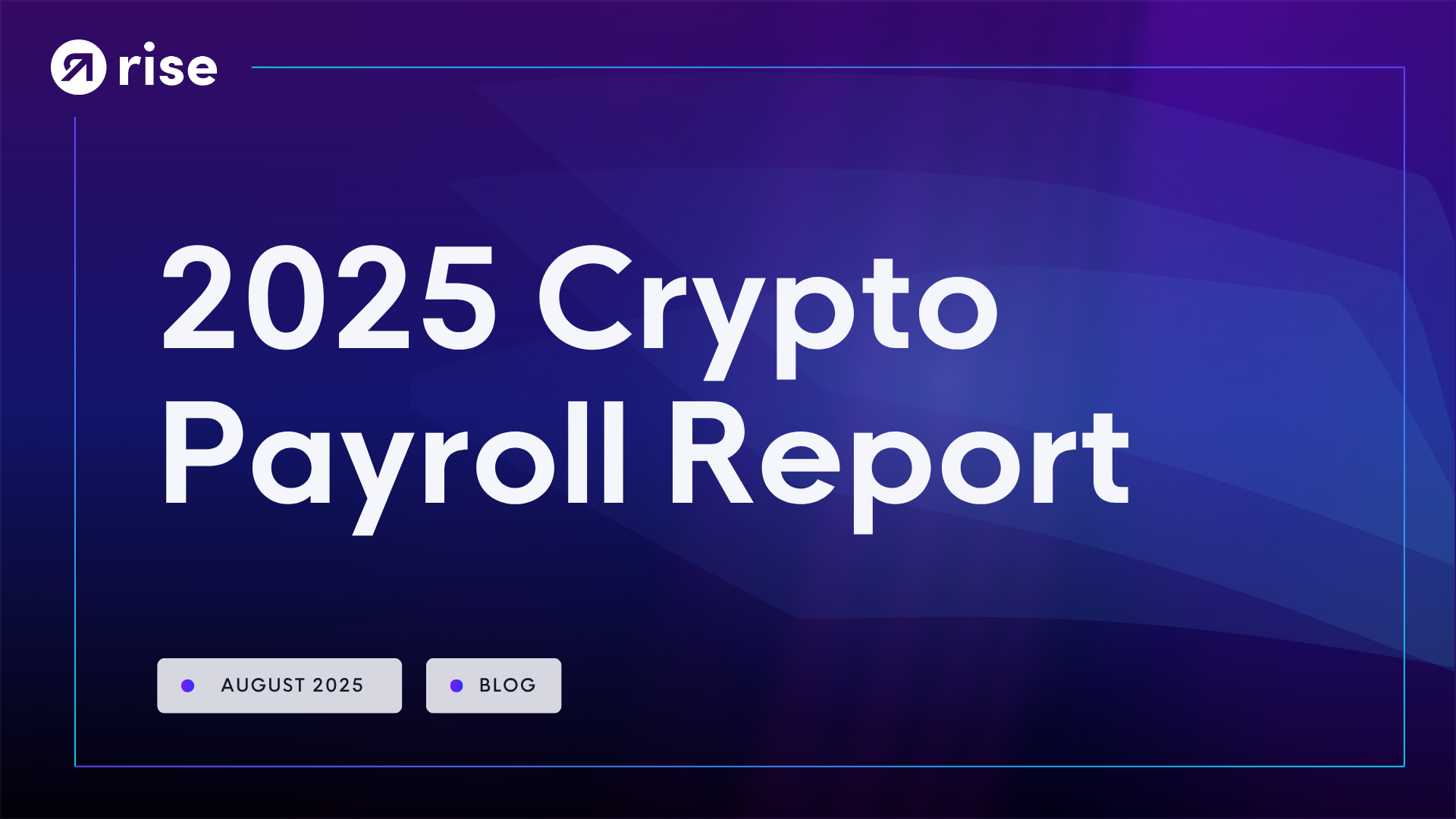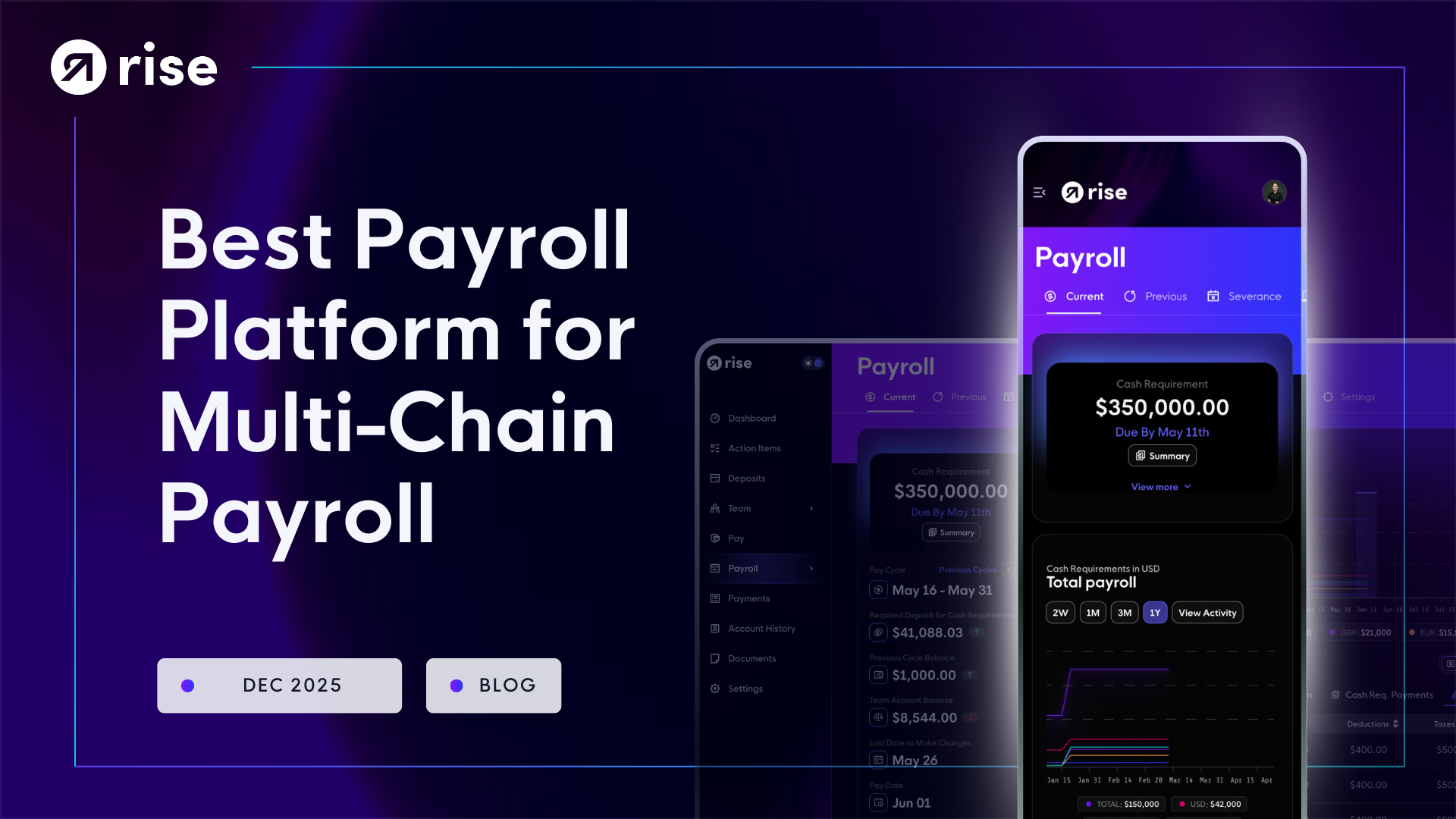While headlines obsess over Bitcoin's price, a more profound transformation is reshaping global payroll: one in four companies worldwide now pays employees in cryptocurrency.
The numbers are staggering.
Individual crypto payroll adoption tripled between 2023 and 2024 before institutions even caught on.
Stablecoins processed $8.9 trillion in just six months of 2025 and three-quarters of Gen Z workers want their paychecks in USDC rather than dollars.
This isn't speculation; it's Argentine designers protecting salaries from inflation, Nigerian startups eliminating 6% banking fees, and a generation treating traditional banking like their parents treated paper checks.
The conclusion is inescapable: crypto payroll has crossed from experiment to essential infrastructure.
The question isn't whether it becomes standard, but how quickly.
Key Takeaways
• Crypto payroll has reached critical mass: 25% of businesses globally now use cryptocurrency for payroll in 2025, with individual adoption surging from just 3% in 2023 to 9.6% by end of 2024 (Pantera survey of 1,600 professionals), while stablecoins processed $8.9 trillion in H1 2025
• USDC dominates through infrastructure advantage: Circle's USDC commands 63% market share (vs USDT's 28.6%) largely because most major payroll providers don't support USDT, besides Rise
• Dramatic cost savings drive adoption: Companies reduce international payroll costs by 95%, from 6%+ with traditional banking to under $5 flat fees per transaction, while settlement times drop from 3-5 days to under 2 minutes
• Younger workforce demands crypto compensation: 75% of Gen Z workers prefer receiving stablecoins as part of their salaries, with Web3 professionals commanding average salaries exceeding $103,000 annually
• Infrastructure has reached enterprise readiness: With platforms like Rise offering 99.9% uptime, regulatory compliance through MiCA, and coverage across 190+ countries, crypto payroll has evolved from experimental to essential business infrastructure
Global Crypto Payroll Adoption Rates: 2023-2025
Cryptocurrency Payroll Adoption Timeline
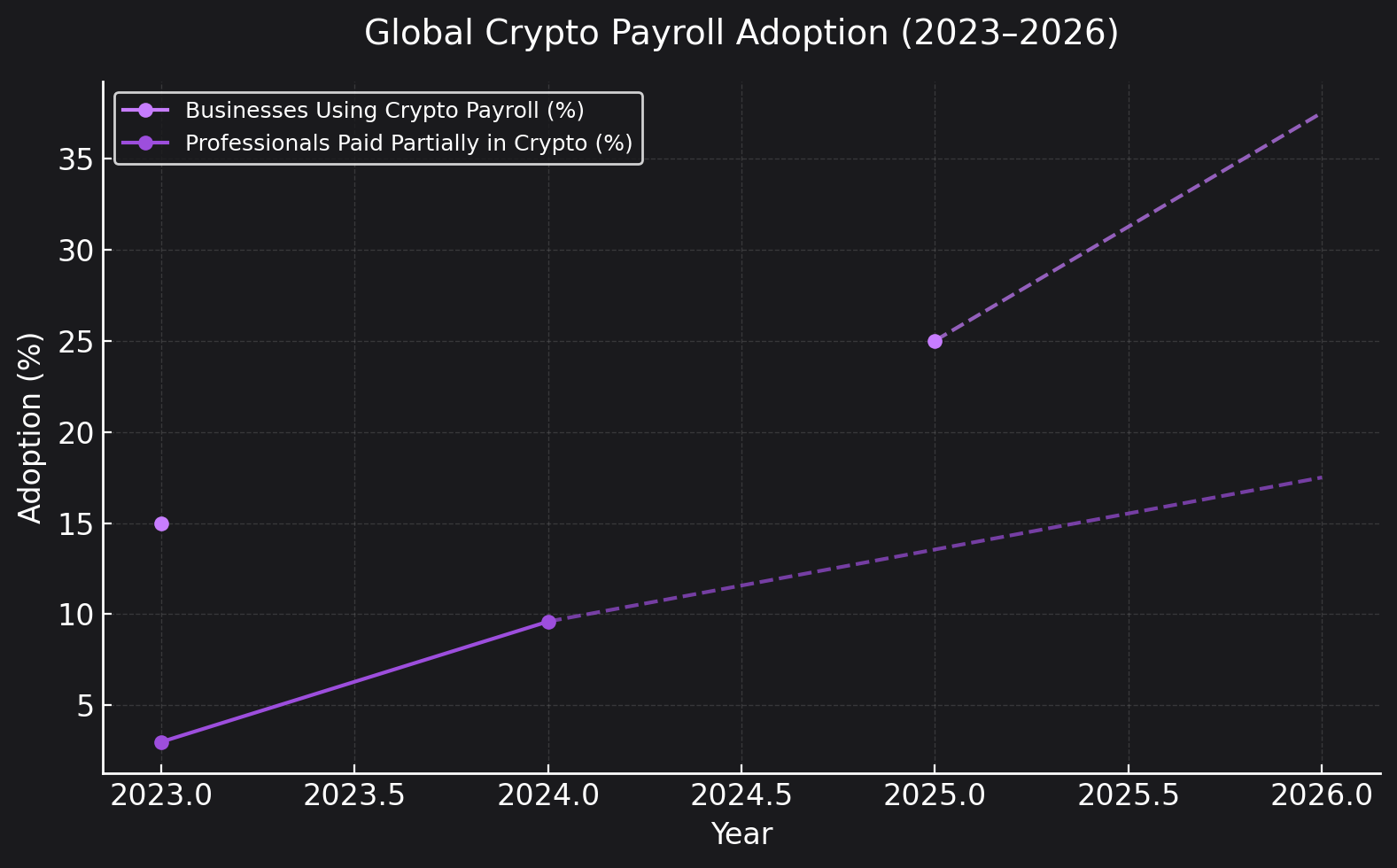
Key Finding: According to Pantera's comprehensive compensation survey of 1,600 crypto professionals across 77 countries, the share of people in the industry being paid in crypto jumped from 3% in 2023 to 9.6% by the end of 2024, a trend that preceded the 2025 stablecoin surge (Pantera Capital).
Business adoption of crypto payroll increased from 15% in 2023 to 25% in 2025 (Rise).
Pantera Survey Demographics and Methodology
The Pantera Compensation Survey provides crucial insights into crypto payroll adoption, drawing from:
- 1,600 respondents across multiple sectors (DeFi, CeFi, gaming)
- 77 countries represented, largely international participants
- Seniority breakdown: 47% senior positions, 29% mid-career, 24% junior employees
- Data collection: Dozens of geographically-distributed startups and hundreds of crypto community participants
This comprehensive dataset reveals that the shift to stablecoin salaries began organically before the 2025 institutional adoption wave, indicating grassroots demand from employees rather than top-down implementation.
Stablecoin Market Share in 2025 Crypto Payroll: USDC vs USDT Dominance
2025 Crypto Payroll Token Distribution
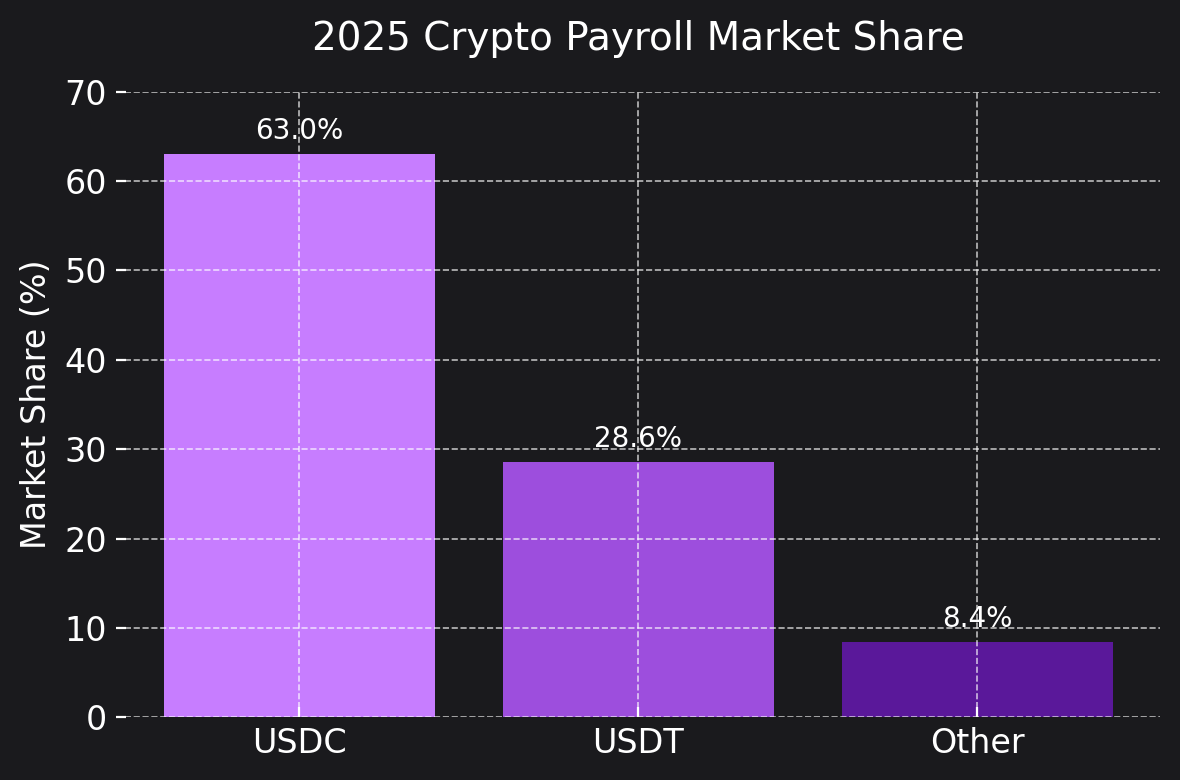
Stablecoin Dominance: According to Pantera's report, "USDC (63%) and USDT (28.6%) collectively account for over 90% of crypto salaries, cementing their status as the go-to choices for payroll stability and liquidity" (Pantera Capital). This trend emerged even before the 2025 institutional stablecoin adoption wave, with employees actively choosing stablecoins over volatile cryptocurrencies like SOL and ETH.
The USDC Advantage: Platform Support Drives Adoption
Pantera's research revealed a critical factor behind USDC's dominance over USDT despite USDT's larger overall market cap: platform support.
"We initially thought this was due to our survey skewing more western. After digging in further, we found it very interesting that none of the major payroll providers in the space (Deel, Remote, Rippling) offer USDT for payroll," the Pantera survey noted.
Rise, however offers both USDC payroll and USDT payroll.
Besides Rise, this infrastructure gap created a significant advantage for USDC, which is supported by:
- All major payroll platforms
- Enhanced regulatory compliance meeting Western standards
- Direct fiat on/off ramps through established banking relationships
The lack of USDT support from major payroll providers, despite international demand, highlights the importance of infrastructure in driving adoption patterns.
Stablecoin Transaction Volumes (2024-2025)
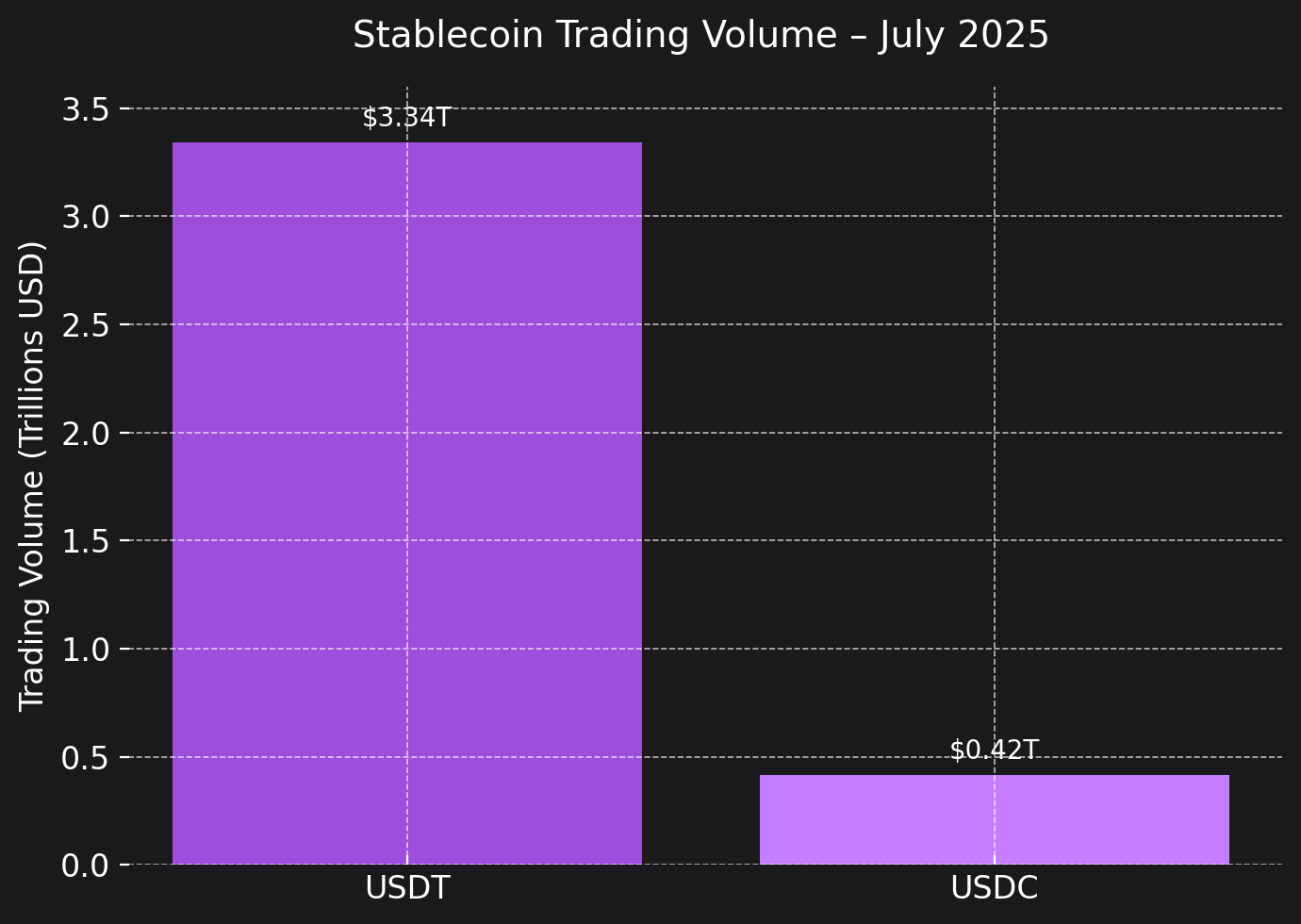
In July 2025, Tether (USDT) once again solidified its position as the most traded stablecoin in the world, moving $3.34 trillion in total volume over the course of the month.
USD Coin (USDC) maintained its position as one of the most trusted and widely used regulated stablecoins, moving $415.09 billion in total trading volume over the course of the month. (Stablecoin Insider)
Cost Comparison: Traditional Banking vs Cryptocurrency Payroll in 2025
International Payroll Cost Structure
Cost Advantage: While the global average fee for sending a traditional cross-border transaction sits at 6.62%, a single international wire from a major U.S. bank can cost $35–$45 plus a 2–4% FX markup, whereas a stablecoin payroll transfer typically lands for less than $3 and lands in seconds.
2025 Web3 Salary Ranges by Role
Cryptocurrency Industry Compensation
Compensation Trends: The average yearly salary of a Blockchain Developer is $150k per year, with a minimum base salary of $78k and a maximum of $262k (Web3.career), while the average web3 salary (globally) is $103,206 per year (CryptoJobsList).
Most In-Demand Web3 Roles in 2025
Freelancer and Gig Economy Crypto Adoption in 2024-2025
Key Statistics for Independent Workers:
- 60% of freelancers have been paid in cryptocurrency at least once as of 2024 (Rise)
- 53% of freelancers choose to withdraw earnings in crypto after fiat funding
- 75% of Gen Z workers prefer receiving stablecoins as part of their salaries (AInvest)
Platform Growth Example: Request Finance processed over $1 billion in crypto payments by early 2025, with monthly payment volumes reaching tens of millions of dollars (Request Finance).
Regional Adoption Patterns: High-Growth Markets for Crypto Payroll
Priority Regions for Stablecoin Payroll Adoption:
- Argentina – Currency inflation protection via USDC/USDT
- Parts of Africa – Banking infrastructure gaps filled by crypto rails
- Southeast Asia – Cross-border payment efficiency for remote workers
- Eastern Europe – Tech talent receiving international payments
Regional Driver: Over 43% of B2B cross-border payments in Southeast Asia now utilize stablecoins (Rise), while countries with unstable banking systems show accelerated adoption.
Rise's Global Impact
Rise's $700+ million in processed payroll spans these high-growth regions, with particular strength in:
- Latin America: Protecting wages from inflation through USDC stability
- Southeast Asia: Enabling instant cross-border payments for remote teams
- Africa: Providing banking access through mobile-first crypto solutions
- Europe: Full MiCA compliance for regulated stablecoin payroll
Top Crypto Payroll Providers in 2025
Market Leaders Comparison

Why Rise Leads the Market in 2025
Rise has emerged as the premier crypto payroll solution, distinguished by three critical advantages that set it apart from competitors:
1. Official Circle Partnership
As an official partner with Circle, the issuer of USDC, Rise offers unparalleled stability and trust in stablecoin payroll. This direct partnership ensures:
- Preferential rates on USDC transactions
- Direct integration with Circle's infrastructure
- Enhanced compliance through Circle's regulatory framework
- Instant settlement with guaranteed 1:1 USD backing
2. $700+ Million in Processed Payroll
Rise has successfully processed over $700 million in total payroll, demonstrating:
- Proven scale serving enterprise clients globally
- Battle-tested infrastructure handling high-volume transactions
- Trust from major companies for mission-critical payroll operations
- Superior reliability with 99.9% uptime track record
3. Native Arbitrum Integration
Built natively on Arbitrum, Rise provides the most efficient blockchain infrastructure:
- Ultra-low fees - typically under $0.50 per transaction
- Lightning-fast processing - transactions confirm in seconds
- Ethereum security with Layer 2 efficiency
- Seamless scalability for growing companies
Comparative Analysis
Traditional Competitors' Limitations:
- Bitwage ($400M processed) relies on older infrastructure without native blockchain integration
- Request Finance includes all payment types in their $1B figure, not exclusively payroll
- Deel and Remote offer crypto as an add-on feature, not core functionality
Rise's Unique Value Proposition:
- Lowest transaction costs through Arbitrum's efficient Layer 2 architecture
- Fastest settlement times with native blockchain integration
- Most compliant platform through Circle partnership and MiCA readiness
- Best user experience with purpose-built crypto payroll interface

Customer Success Metrics
Rise's platform superiority is reflected in customer outcomes:
- 68% cost reduction compared to traditional international payroll
- 2-minute average settlement time for stablecoin payments
- Zero security incidents since inception
- 24/7 global coverage across 190+ countries
Infrastructure Scale: While Bitwage has processed over $400 million in crypto payroll for more than 4,500 businesses (BlockTelegraph), Rise's $700+ million processed with native blockchain architecture and Circle partnership positions it as the clear market leader for enterprise crypto payroll.
Regulatory Compliance Framework for 2025 Crypto Payroll
Key Regulatory Considerations:
- EU MiCA Regulation (Markets in Crypto-Assets) – 14 stablecoins are now fully regulated under MiCA or equivalent national regimes (Rise)
- GENIUS Act - the first federal stablecoin framework
- US AML Requirements – Anti-Money Laundering compliance for US entities
- Tax Reporting Obligations – Automated 1099 and W-2 equivalent reporting
- KYC/AML Procedures – Know Your Customer verification for all payroll recipients
Compliance Innovation: 71% of leading stablecoins publish real-time proof-of-reserves reports (Rise), building trust and enhancing transparency.
Hybrid Payroll Models: Balancing Fiat and Cryptocurrency in 2025

Typical Hybrid Structure:
- 50-80% paid in traditional fiat currency (USD, EUR, etc.)
- 20-50% paid in stablecoins (primarily USDC or USDT)
- Optional 5-10% in volatile cryptocurrencies (BTC, ETH) for investment-minded employees
Risk Management: Companies implement hybrid payroll models to balance the efficiency of crypto payments with volatility management and regulatory compliance needs.
Future Outlook: Projected Growth Through 2026
Growth Projections Based on Current Trends:
- 2026 Business Adoption: Expected to reach 35-40% globally
- Professional Participation: Projected 15-20% receiving partial crypto salaries
- Stablecoin Volume: Anticipated $20+ trillion annual transaction volume
- Gen Z Preference: 75% of Gen Z stablecoin users would prefer to receive their salaries in stablecoins (AInvest)
Momentum Indicator: With younger workers showing strong preference for stablecoin compensation, future adoption appears assured as this demographic advances in their careers.
Conclusion: Crypto Payroll as Mainstream Infrastructure in 2025
The 2025 crypto payroll landscape demonstrates clear mainstream adoption with 25% of global businesses utilizing digital currencies for compensation, dominated by USDC's 63% market share.
The $8.9 trillion USD in stablecoin transactions during the first half of 2025 proves infrastructure readiness.
With average Web3 salaries exceeding $103,000 USD annually and transaction costs reduced by over 95% compared to traditional methods, crypto payroll has evolved from experimental technology to essential business infrastructure.
Final Thoughts
Companies adopting crypto payroll in 2025 gain access to global talent pools, reduce international payment costs from 6% to under $5 USD per transaction, and meet the compensation preferences of younger workers, with 75% of Gen Z preferring stablecoin payments.
Rise's platform, with our Circle partnership, $700+ million processed, and native Arbitrum integration, provides the most efficient and compliant solution for enterprises transitioning to crypto payroll.
Frequently Asked Questions (FAQ)
Q1: What percentage of companies use cryptocurrency for payroll in 2025, and how has this changed?
In 2025, over 25% of businesses worldwide use cryptocurrency for payroll, representing a 66.7% increase from 15% in 2023. Individual adoption has grown even faster - Pantera Capital's survey of 1,600 professionals found that crypto salary adoption surged from just 3% in 2023 to 9.6% by the end of 2024, indicating strong employee-driven demand that preceded institutional adoption.
Q2: Which cryptocurrencies are most commonly used for salary payments?
Stablecoins dominate crypto payroll, accounting for over 90% of all digital salaries. USDC leads with 63% market share, followed by USDT at 28.6%. Together, these two stablecoins represent 91.6% of the crypto payroll market. Volatile cryptocurrencies like Solana (1.9%) and Ethereum (1.3%) make up less than 5% combined. USDC's dominance is largely due to infrastructure support as major payroll providers like Deel, Remote, and Rippling don't offer USDT, giving USDC a significant platform advantage.
Q3: How much can companies save by switching to crypto payroll?
Companies can achieve dramatic cost savings of up to 95% on international payments. Traditional cross-border transactions cost an average of 6.62% of the transaction value (often $35-45 plus 2-4% FX markup for wire transfers), while crypto payroll transactions cost just $2-5 in flat fees regardless of the amount. Additionally, settlement times drop from 3-5 business days to under 2 minutes for stablecoins and approximately 19 minutes for Bitcoin.
Q4: What is the best crypto payroll platform for enterprises in 2025?
Rise leads the market with three key advantages:
(1) Official partnership with Circle (USDC issuer) providing preferential rates and enhanced compliance,
(2) Over $700 million in processed payroll demonstrating proven scale, and
(3) Native Arbitrum integration delivering ultra-low fees under $0.50 per transaction.
Rise offers 99.9% uptime, 24/7 coverage across 190+ countries, and achieves 68% cost reduction compared to traditional payroll methods, with 2-minute average settlement times.
Q5: Why do younger workers prefer cryptocurrency salaries?
75% of Gen Z workers prefer receiving stablecoins as part of their salaries, driven by several factors: instant global payments without banking delays, protection from local currency inflation (especially in emerging markets), access to DeFi yield opportunities, and alignment with digital-first financial habits. This demographic shift is significant as Gen Z enters the workforce and their preference for crypto compensation is pushing companies to adopt these payment methods to attract top talent. Average Web3 salaries exceeding $103,000 annually also make crypto-friendly positions particularly attractive.
Sources and References
Primary Data Sources:
- Pantera Capital - Compensation Survey 2024 (1,600 respondents across 77 countries)
- Rise - Crypto Payroll Management Guide & Stablecoin Statistics 2025
- AInvest - USDC Market Share in Crypto Salaries Report
- Bitwage - Cryptocurrency Payroll Platform Statistics
- Request Finance - Monthly Transaction Reports and $1B Milestone
- CryptoJobsList - Web3 Salary Database
- Web3.career - Blockchain Developer Salary Statistics
- Metana - Web3 Developer Salary Guide 2025
- CryptoNinjas - Gen Z Stablecoin Preference Survey
- Cointelegraph - Bitcoin Transaction Confirmation Times
- Circle - USDC State of the Economy Report 2025
Additional Research Sources:
- Pantera Capital - Crypto Salary Report 2024
- Security.org - 2025 Cryptocurrency Adoption Report
- CoinMarketCap - Stablecoin Market Statistics
- BlockTelegraph - Bitwage $400M Processing Milestone
- Various blockchain analytics platforms for transaction data
Note: All statistics are sourced from publicly available reports and surveys conducted between 2023-2025. Market conditions and adoption rates may vary.





